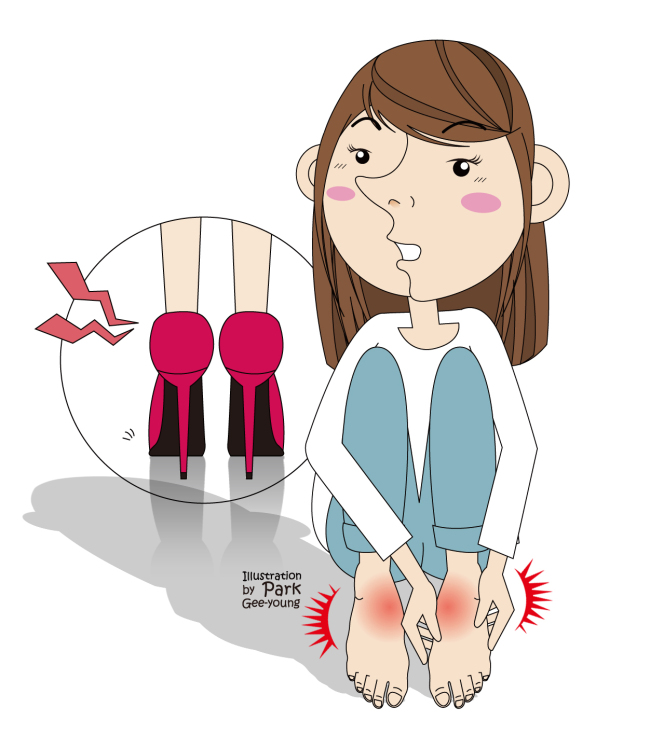 |
|
Illustration by Park Gee-young |
Although the feet are only a small part of your body, they consist of 26 bones, including the phalanges, calcaneus and scaphoid. More than a hundred small muscles and ligaments form a complex network between these bones.
The feet are responsible for the load of your body weight. Your feet are also responsible for making you move forward. The average 60-year- old has walked 160,000 kilometers during his or her lifetime, a distance equal to four times the circumference of the earth.
Your feet also help pump the blood pooling in the lower limbs back up to the heart, and for this reason they are sometimes called “the second heart” of the body. They are prone to various conditions due to many different reasons.
Splayfoot
The balls of your feet are responsible for absorbing your body weight. People with splayfoot are either born without an arch in their feet, or have an arch deformation due to trauma to the inner foot, leading to the stretching of the plantar fascia that acts as a spring.
Treatment for splayfoot starts after X-rays check that there are no inflamed joints in the feet. If a patient has light symptoms such as fatigue, without pain, inner soles or arch pads can be used to create an artificial arch in the feet. They may also need to do exercises to strengthen the muscles around the arch.
Exercises such as picking up a towel with the toes can be done at home, but cannot solve the underlying problem. Patients with severe pain may need surgery of the bones to create an arch, such as joint fixation procedures. This requires the patient to stay in the hospital for about two weeks, and the patient can start walking after 6-8 weeks.
Hallux valgus
This is a condition where the big toe is bent inward, leading to cosmetic problems as well as pain when wearing shoes. It is called “beoseon feet” in Korea, after the word for traditional socks, because the toes bend as those of an old lady who wears tight beoseon.
Wearing high heels or tight, thin shoes for long periods leads to shortening of the tendon that bends the toes up and down, ceasing a to protrusion of the back of the big toes.
It is also seen in people with a short Achilles tendon or very flexible joints.
Hallux valgus can affect other toes, leading to callus and neuromas, which is why it must to be treated early. This condition can be treated non-surgically without any complications.
Ankle sprain
The ankle joint consists of the tibia (the shin bone) and the cubic ankle bone. There are two malleoli bones on either side of the joint, which secure the foot and ankle joint. These are why our ankles freely move up and down, but have very limited side-to-side movement.
The ankle joint is supported by various ligaments that form a network around the inside and the outside of the joint. These ligaments are responsible for preventing the ankle joint from twisting due to external forces. However, excessive force from the side of the ankle joint can lead to a sprain. This is a condition in which the ligaments of the ankles partly tear.
The inner ligament is 10 times thicker than the outer ligaments. The outer ligaments consist of several pieces, and their thickness is only one-tenth that of the inner ligament, which means that it is much more prone to damage.
Although uncommon, trauma to the inner ligament can occur. This can lead to splayfoot, because the inner ligament is involved in creating the arch of the foot, which plays a role in absorbing the shock from the weight. Therefore, people with splayfoot cannot walk for long periods of time, and this can also lead to various systemic conditions.
Treatment for the first three days following ankle sprain is important. Use ice in a plastic bag to cool the area, and put your feet up higher than your heart to reduce the swelling. Fix the area using prosthetics to stop the movement of the torn ligament to allow the ligament to heal.
If you still feel pain or feel weakness in your ankles when walking down steps even after the swelling has gone, you should be seen by a doctor for an accurate diagnosis of the extent of the damage and for appropriate treatment. Those who have bent back axis of the ankle joint can experience ankle joints again, so they should be seen by a specialist for treatment.
To prevent ankle sprain, it helps to exercise the small muscles inside and outside the joint to strengthen them. Use a rubber band between your toes and bend your toes inside or to the sides. It also helps to lift up one foot and swing your arms as if you are skiing, to strengthen the muscles in your ankles. This exercise requires some strength, so choose exercises appropriate for you.
Hindfoot pain syndrome
Hindfoot pain syndrome is caused by inflammation of the plantar fascia. Its exact cause is unknown, but it is more common in those with rheumatoid arthritis, obesity or splayfeet.
The main symptoms include acute pain when first stepping down after waking up, or when standing up after sitting for a long time. It tends to get better with walking. Treatments include exercise therapy, such as placing the tip of your feet on steps and standing, to extend the Achilles tendon. Many people see an improvement after doing this exercise for several months.
Inflammation of the Achilles tendon
This condition leads to protrusion of the heels backwards and bursitis around the Achilles tendon. It is commonly seen in those who suddenly start vigorous exercise after being inactive for some time. It is often associated with trauma, and treated with physiotherapy in most cases.
Ingrown nails
Inflammation from ingrown toenails can cause a small tumor called pyogenic granuloma. It is a relatively common condition. People can trim their toenails but the toenails grow again to cause pain. It is more common in those who wear tight shoes and have deformities in their feet, or those who tend to trim their toenails in a circular and short shape.
In minor cases, patients can put cotton balls under the edge of the toenails and take antibiotics. However, in severe cases, an operation must be done to remove a portion of the root of the toenails. Previously it was common practice to remove part or all of the toenail, but the condition can recur when the toenails grow again. More recently, surgeons tend to remove the root of the toenails. The surgery is very simple, and patients can return to their daily activities immediately. It helps to wear comfortable shoes and keep your toenails long enough so that the edge of the toenails extend out to the end of the toes to prevent this condition.
 |
|
Park Min-jong |
By Park Min-jong
The author is a doctorin the Department of Orthopedic Surgery at Samsung Medical Center and a professor at Sungkyunkwan University School of Medicine. ― Ed.